Abstract
This paper develops an approach to investigation of a solid as an integral system whose fundamental properties are determined by the energetics of its structure. Addressing the subject from a unified viewpoint, we consider the formation, accumulation, and transformations of defects in silicate and aluminophosphate glasses, which emit electromagnetic waves in a wide frequency range as a result of cracking. It has been shown that electron irradiation causes spontaneous electrical discharges, whose magnitude depends on the electron energy and irradiation time. The discharges occur at surface defects. Brush discharges develop in a layer where charged particles are distributed. In a thin layer of a charged dielectric, we observe a breakdown effect. The electrical discharge concentrates at surface defects, which can be produced in advance. A discharge can be initiated by approaching a grounded metallic tip to a charged surface even some time after irradiation. A discharge, mechanical loading, cooling, or heating of glass is accompanied by not only a light burst but also electromagnetic emission (EME), which correlates well with a polymorphic transformation process, thermoluminescence, etc. Thus, the release of accumulated energy from unirradiated and irradiated inorganic glasses on heating and cooling is accompanied by pulsed EME, whose intensity depends on the energy stored in the material.
Similar content being viewed by others
References
Vorob’ev, A.A., Electromagnetic emission during crack formation in dielectric materials, Defektoskopiya, 1977, no. 3, pp. 128–129.
Vorob’ev, A.A., Detection of electromagnetic pulses during the thermal excitation of irradiated phosphate glasses, Fiz. Khim. Stekla, 1977, vol. 3, no. 3, pp. 373–375.
Bocharova, T.V., Sysoev, D.S., Aseev, V.A., and Tagil’tseva, N.O., Radiation-induced color centers in phosphogermanate glass-like materials, Glass Phys. Chem., 2015, vol. 41, no. 4, pp. 378–384.
Avramenko, D.S., Nikonorov, N.V., Stepanov, S.A., and Tsekhomskii, V.A., Effect of X-ray radiation on a potassium aluminaborate glass system, Glass Phys. Chem., 2015, vol. 41, no. 5, pp. 478–483.
Fedorov, B.V., Radioelectret Effect in Phosphate Glasses, Tyumen: Tyumensk. Gos. Neftegazovyi Univ., 1998, p. 196.
Vorob’ev, A.A., Zavertkin, S.D., and Sal’nikov, V.N., Observation of acoustic and electromagnetic pulses during the relaxation of a thermally excited state of some dielectrics, Izv. Vyssh. Uchebn. Zaved., Fiz., 2007, no. 2, pp. 132–134.
Bertin, E.P., Principles and Practice of X-Ray Spectrometric Analysis, New York: Plenum, 1975, pp. 345–350.
Chepeleva, I.V., Ermakovich, K.K., and Tver’yanovich, Yu.S., Temperature annealing of radiation defects in xCu2Se–(1–x)As2Se3 glasses: dependence on composition, Glass Phys. Chem., 2013, vol. 39, no. 1, pp. 57–63.
Fedorov, B.V., Sal’nikov, V.V., and Zavertkin, S.D., Radio emission: a new method for investigation of solid dielectrics, in Razrabotka elektrokhimicheskikh i opticheskikh metodov i ikh primenenie v fiziko-khimicheskikh i analiticheskikh issledovaniyakh (Electrochemical and Optical Methods: Development and Application in Physicochemical and Analytical Characterization), Tyumen, 1976, pp. 150–156.
Vorob’ev, A.A., Zavadovskaya, E.K., Starodubtsev, V.A., and Fedorov, B.V., Effect of irradiation on the physical properties of aluminophosphate glasses and the energy of their chemical bonds, Fiz. Khim. Stekla, 1977, vol. 3, no. 1, pp. 54–58.
Fedorov, B.V., Effect of the charge accumulated in glass under irradiation on electromagnetic emission intensity, in Elektretnyi effekt i elektricheskaya relaksatsiya (Electret Effect and Electrical Relaxation), Moscow, 1979, pp. 142–149.
Author information
Authors and Affiliations
Corresponding author
Additional information
Original Russian Text © B.V. Fedorov, N.B. Panchenko, Yu.S. Berdova, 2018, published in Neorganicheskie Materialy, 2018, Vol. 54, No. 8.
Rights and permissions
About this article
Cite this article
Fedorov, B.V., Panchenko, N.B. & Berdova, Y.S. Effects of Mechanical Load and Ionizing Radiation on Glass. Inorg Mater 54, 844–850 (2018). https://doi.org/10.1134/S0020168518080058
Received:
Accepted:
Published:
Issue Date:
DOI: https://doi.org/10.1134/S0020168518080058



